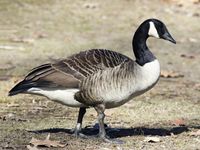Difference between revisions of "Ornithology/Anseriformes"
m (Styled templates into pretty format. For any comments/concerns, please contact User:Pepperonipi.) |
m (Styled the page according to my stylist. For concerns, see my user page.) |
||
| Line 84: | Line 84: | ||
| diet = Water plants, grasses, and grain. | | diet = Water plants, grasses, and grain. | ||
| cons = lc | | cons = lc | ||
| − | | 1 | + | | 1 = |
}} | }} | ||
||{{bird | ||{{bird | ||
| Line 151: | Line 151: | ||
| diet = Aquatic invertebrates, especially mollusks, crustaceans, and sea urchins | | diet = Aquatic invertebrates, especially mollusks, crustaceans, and sea urchins | ||
| cons = lc | | cons = lc | ||
| − | | 1 | + | | 1 = |
}} | }} | ||
|- | |- | ||
Revision as of 15:41, 26 August 2020
- Main article: Ornithology
Anseriformes is an order containing ducks, geese, and swans.
Ducks, Geese, and Swans (Anatidae)
The family Anatidae consists of medium-sized to large waterbirds, including ducks, geese, and swans. There are 10 species in this family on the 2020 Official Bird List. Most members of this family are distinguished by large, horizontally flattened bills, longs necks, short tails, and webbed feet. They have lammelae in their bills which aids in filter feeding. Young of this family are precocial. These birds have often been used for hunting and food. The feathers are used to stuff beds, pillows, etc.
Ducks
Ducks are a mostly aquatic assemblage of sub-families of Anatidae. Ducks differ from geese and swans in several ways. They are smaller, have shorter necks, exhibit sexual dimorphism, do not exhibit strong pair bonding, and have nostrils placed higher on their bills. Ducks have a structure on the side of their beak that serves as a comb to filter food and aid in preening. Ducks either dabble or dive. Diving ducks swim below the surface to forage. Dabbling ducks feed on the surface of water and stick their heads underwater to collect vegetation near the surface. The only duck that requires a call in the 2020 season is the mallard, however in previous years the black-bellied whistling duck required one as well (found here).
|
| ||||||||||||||||||||||||||||||
|
| ||||||||||||||||||||||||||||||
| |||||||||||||||||||||||||||||||
Diving Ducks
Diving ducks are similar in appearance to dabbling ducks. However, instead of dabbling they actually dive under water for their food. They belong to the subfamily Aythyinae. They are commonly called pochards and scaups. There is one diving duck on the Science Olympiad bird list.
| ||||||||||||||
Geese
Geese are a division of the family Anatidae. They are generally in between the sizes of the other two main groups- they are larger than the ducks, but smaller than the swans. They exhibit strong pair bonding, but unlike most monogamous species, are only territorial during the breeding season. The paired individuals are more dominant and eat more, contributing to them having more offspring. There are two geese on the Science Olympiad bird list.
Swans
Swans are the largest of the three types of birds in Anatidae, and are among the largest flying birds. They are much more closely related to geese than ducks, and are grouped with geese in the subfamily Anserinae. They are not sexually dimorphic in plumage, but males are usually larger than females. Their plumage is all white in the Northern Hemisphere, but they can be a mix of black and white in the Southern Hemisphere. They generally live in temperate environments. They are almost entirely herbivorous. Swans mate for life, and may lay 3-8 eggs in a clutch. There is one swan on the Science Olympiad bird list.
| ||||||||||||||||
Sea Ducks
As their common name implies, the members of the subfamily Merginae are usually marine. Some mergansers prefer river habitats. They usually eat aquatic life. There have been 4 sea ducks on the Science Olympiad bird list in the past, but for the 2020 season there is only one.
| ||||||||||||||
Previous Birds
| ||||||||||||||||||||||||||||||||||||||||||||||||||||||||||||















